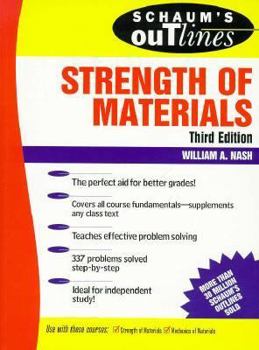Schaum's Outline of Theory and Problems of Strength of Materials: Including Hundreds of Solved Problems
Select Format
Select Condition 
Book Overview
This edition contains 12 computer programs and treats stress concentrations and fracture mechanics. It also includes 345 solved problems. New problems to this edition stem from contemporary... This description may be from another edition of this product.
Format:Paperback
Language:English
ISBN:0070459037
ISBN13:9780070459038
Release Date:January 1994
Publisher:McGraw-Hill Companies
Length:423 Pages
Weight:1.80 lbs.
Dimensions:0.7" x 8.2" x 10.9"
Customer Reviews
6 ratings
It's Okay at Best, but it has it's flaws.
Published by Renaissance Man Andrew , 3 years ago
Anyone who has read my engineering book reviews know who my favorite three authors are, in my pursuit of other like minded authors I came across William Nash's Strength of Materials 4th Edition. Reading through this book and answering the questions, the early signs of weakness begin to show starting in Chapter 7 – Centroids, Moments of Inertia, and Products of Inertia of Plane Areas, but become full blown by Chapter 9 – Elastic Deflection of Beams: Double-Integration Method. The first 6 chapters, which cover basic tensile, compressive, and shear stresses in the context of pressure vessels, axial applications, and beams, will give students, both beginner and post graduate, a thorough workout. But as stated before when one reaches Chapter 9, the clarity of expression and instruction diminishes to the point that one is left frustrated.
An easy method that Nash, et al can follow when introducing any topic is to start as simple as possible and then progress to what appears to be more complex application of said topic. For instance, if I were teaching students beam deflection via the Double Integration Method, I would describe the deflection equation in much the same way Nash illustrated in his book, however, where I would depart from Nash is showing students where each of the moments come from primarily through a free body diagram and then mathematically. Such a simple method becomes a powerful force for students to grasp a topic even a topic that on the surface that appears complex like the Double-Integration Method. I detail this method of instruction on my blog, however I use heat conduction as the example rather than beam deflection.
As I became familiar with Nash's Strength of Materials, he's obviously someone who knows what he is doing, but his ability to express himself is lacking. I think with a little guidance from an editor and perhaps modeling his writing abilities after Michael Lindeberg, Jon Bird, and/or Joseph Shelly, Nash will have a book that can contend with the aforementioned authors. And do to these expressive problems in the latter half of his book, I can only give this book a 3 our of 5 stars.
A Great Book - Better than the Combined Strengths/Statics by Nash
Published by Thriftbooks.com User , 15 years ago
I obtained this text in an older edition, around 1994. Although I had a college course in strengths, I really learned what I know through using this book and working all the problems. Later I found an even older edition of the Nash book at a used bookstore. I believe the copyright for this was around 1960 +/- 5 years. So it is probably one of the oldest Schaum titles, and it is the one I found most useful in my career in structural engineering and for passing the FE and PE exams. I have not looked at any recent editions, however provided that the editors retained the Nash chapters that use classical methods for calculating axials, shears, moments, deflections and stresses, you WILL learn by going through this carefully and working the problems in the back of each chapter. At some point this book was not available, and only the combined Strengths/Statics book by Nash was offered. I have that also (an early edition) and believe that it is not quite as good as the one devoted solely to strengths (this book.)
Excellent book for beginners and pros
Published by Thriftbooks.com User , 18 years ago
This is an excellent book. Very well written and with very explicit examples for a beginner or a pro. The new facts are the programs for some beams, columns and typical elements of strength of materials. The reading is easy and the processes are very simple and the exmaples are very clear.
Strength of Materials
Published by Thriftbooks.com User , 18 years ago
I found the book to be very useful in that it summarizes my class textbook and offers many worked out example problems. I have since purchased Schaum's for my other classes and I find them equally useful
Well written book
Published by Thriftbooks.com User , 24 years ago
I have already finished courses in strength of materials etc., and am using this book as a reference, instead of those voluminous handbooks. The book is very well written and William Nash has an excellent, straight forward way of putting forth the key points. The book has all the information you might need for a first course in strength of materials. I also use this book in conjunction with a finite element text to give me the theoretical values for comparison. In summary, if you need a solid backup for your textbook and a useful reference, you won't go wrong with this one.
An excellent book for first course.
Published by Thriftbooks.com User , 24 years ago
This book is very good. First year students will find it very user friendly. Even a graduate engineer may need it to brush up previouly learned skills. All topics - e.g. material properties, stress, beam deflection, bending moments, columns, etc. are covered in very lucid manner. A must book for EVERY engineer.





